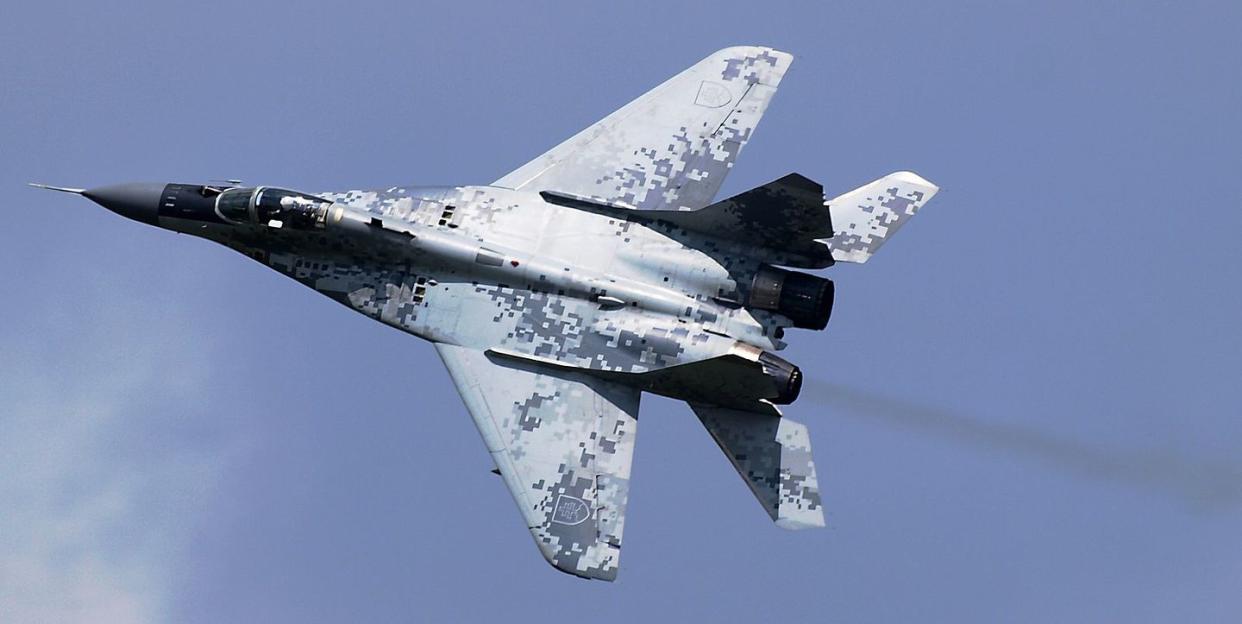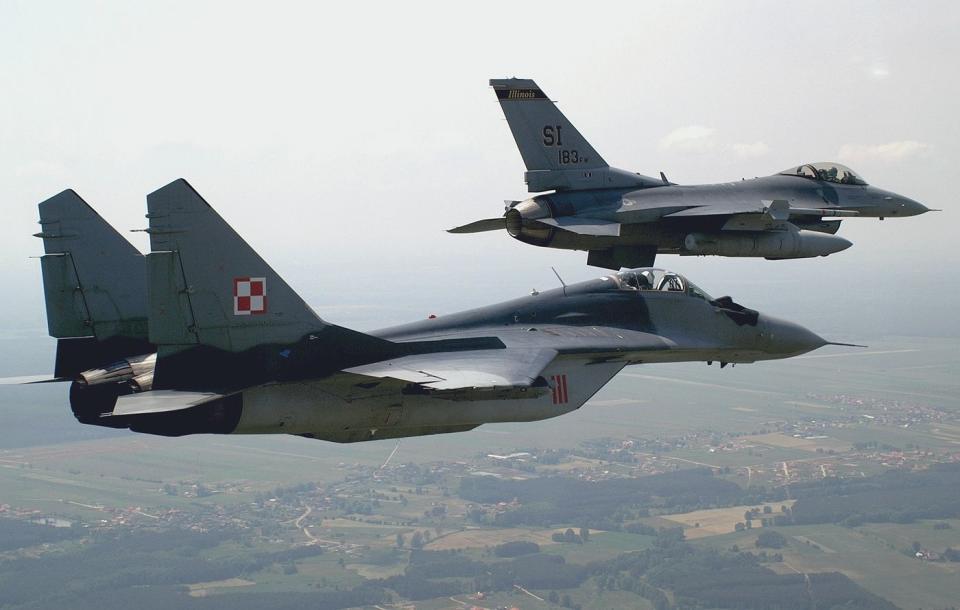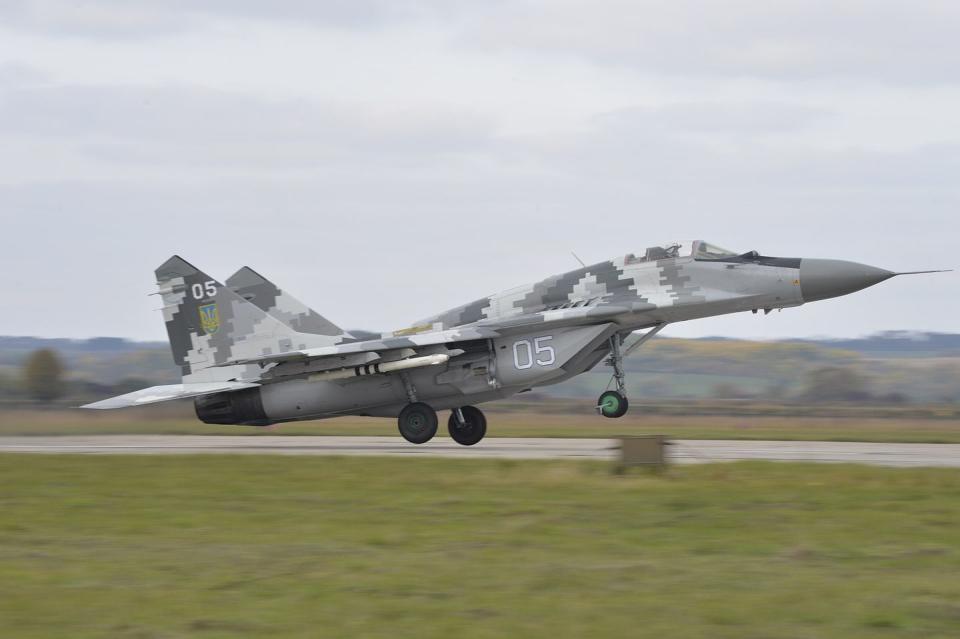Ukraine Is Finally Getting Some Badly Needed MiG-29 Fighter Jets From NATO

Over a year after a European Union representative first announced plans to transfer jet fighters to Ukraine, last Thursday, Poland finally announced it was moving ahead to deliver to the Ukrainian Air Force four Soviet-vintage MiG-29 jets with which to combat Russia’s massive new multi-front invasion, with eight more to follow eventually.
Then on Friday, Slovakia’s Prime Minister Eduard Heger announced his country was also finally proceeding with plans it had long aired publicly to transfer its 13 MiG-29s to Ukraine. The country’s only remaining combat aircraft, these had been retired last August, due to be replaced by 14 American-built F-16V jets. Until those arrive, fighters from the Czech Republic and Poland are deployed to Malacky airbase to defend Slovakian airspace, per an agreement.
The United States will also compensate for the transfer with $745 million in compensation/defense goods, while the European Union is pitching in 200 million euros. The deal is opposed by the SMER-Social Democracy populist party, which disapproves of support to Ukraine and could potentially win an election this September.
Because Ukrainian pilots and maintainers have operated MiG-29s for decades, they can use the old Soviet jets far more readily than new types. Despite these being the first transfers of fully assembled jet fighters to Ukraine, Kyiv earlier proved capable of increasing the number of MiGs in service due to transfers of spare parts from NATO members, allowing it to reactivate dilapidated airframes.

These initial donations may be followed by additional MiG-29s from Poland, or even from Bulgaria.
The White House initially indicated its support for transferring MiG-29s to Ukraine in early March 2022. But its stance changed radically later that month, and it effectively quashed those early MiG transfer plans. The Spectator eventually revealed in an article that Washington was compelled to block MiG-29 transfers as part of deal a with China, which in turn allegedly applied pressure on Russia to cease threatening use of nuclear weapons in Ukraine.
In retrospect, Beijing’s fear that transferring jet fighters to Ukraine amounted to a dangerously escalatory threshold seem misplaced, given that subsequent Western transfers of artillery were far more important for Ukraine and lethal to Russian forces. In any case, a Washington-Beijing deal appears to have met its expiration date.
Slovakia’s Fulcrums
The twin-engine MiG-29, NATO codename ‘Fulcrum’, was developed as an agile and relatively affordable and exportable short-range tactical fighter analogous to the U.S. F-16. It was meant to provide air cover for the Red Army and engineered to withstand operations from rugged forward airstrips.
It benefited early in service from the then cutting-edge R-37 short-range heat-seeking missile, though its beyond-visual-range capability was limited by its relatively short-range N019 radar and less impressive R-27 and R-77 medium/long-range missiles.
Though built to fend off NATO warplanes, the Western alliance ended up inheriting dozens of the Soviet jets when East European states joined NATO following after end of the Cold War.
Slovakia inherited nine single-seat MiG-29As (known as Project 9.12s) and one two-seat MiG-29UB upon the dissolution of Czechoslovakia. Slovakia subsequently acquired 12 more MiG-29As and two MiG-29UBs from Russia as a debt repayment between 1993-1996.
In the mid-2000s, 10 MiG-29As and two UBs were upgraded by Russian Aircraft Corporation technicians to an improved MiG-29AS or MiG-29UBS model aimed primarily at achieving air safety and NATO interoperability standard. New components included Rockwell-Collins navigation/communication systems, IFF systems, and new cockpit computer and LCD displays supported by a digital processor.
However, poor readiness and maintainability of its RD-33 engines meant only a handful of Slovakian MiGs were useable for operations or training at any one time, leading to a decision in 2018 to retire the type.
By the time Slovakia retired its last MiGs in August 2022, it was reportedly down to only one pilot still actively flying airspace patrols, and armed only with a gun due to Slovakia lacking air-to-air missiles in service.
Poland’s Fulcrums
Poland received its first 12 MiG-29s in 1989, followed by 10 used aircraft purchased from the Czech Republic in the mid-1990s and 22 acquired for one euro apiece from the German Air Force (though only 11 remained long in operational service.)
Between 2017-2019, three Polish MiG-29As were lost in crashes, one of them fatal. All of Poland’s remaining 21 MiG-29As and six two-seat MiG-29UBs are modernized with new navigation system and GPS receivers, Thompson SB-14 radar warning receivers, and VHF/UHF radios. A subset of 16 were jointly updated by WZL and Israeli firm IAI with a MIL-1553B databus, color multifunction displays, and modern mission computers.
Currently, the PAF’s 1st and 41st Tactical Squadrons still operate the type at Minsk Mazowiecki and Malbork, respectively. These included a half-dozen MiG-29UBs, while the rest were single-seat MiG-29As.
The MiG-29s were due for eventual retirement as the Polish Air Force acquired F-16s, and will soon receive F-35A stealth fighters. After Russia invaded, Warsaw even said it would gladly give all its MiGs away to U.S. for transfer to Ukraine in exchange for U.S. F-16s.
The Polish and Slovak MiGs are specifically the Object 9.12A export model with downgraded N019E radars, computer processors, and OEPrNK-29E electrooptical sensors, and without wiring for nuclear weapons use. That makes them inferior to most Ukrainian MiGs, which were Object 9.13 Fulcrum-Cs (which includes a Gardeniya self-defense jammer in a hump behind the conflict), and without export-model downgrades.
Ukraine’s Soviet-Built Defender
MiG-29s are the most numerous jet fighter in the Ukrainian Air Force, alongside a smaller force of beefier Su-27 jets comparable to the F-15A fighter. Ukraine’s Fulcrums serve in the in its 40th, 114th,and 204th Tactical Aviation Brigades, and play a frontline role in its resistance against Russian invasion.

Though Russia’s air force still operates an estimated 267 MiG-29s, and a handful of similar but modernized MiG-35s, it has not deployed any for combat over Ukraine.
In the early days of Russia’s 2022 invasion, Ukrainian MiGs were recorded battling Russian military aircraft that descended on Kyiv and nearby Hostomel airport, though a number were shot down in the process. Moreover, personnel of the 40th Brigade had to repel a nighttime ground attack by Russian commandos at Vasylkiv.
While several MiG-29s were lost in air-to-air combat around Kyiv, Zhitomyr, and Mykolaive, Russian attacks on MiG bases destroyed only a few aircraft due to effective dispersal before hostilities.
Undoubtedly, Ukraine’s MiG-29s—even more than its Su-27s—are significantly outclassed by more modern Russian fighters, which benefit from farther-seeing radars, longer-range R-77-1 and R-37M air-to-air missiles, and support from A-50 Mainstay airborne early warning planes. But aided by ground controllers, the UAF’s MiGs and Su-27s have sustained a sort of aerial guerilla warfare approaching Russian aircraft from low altitude to mask against radar detection, and ducking back to friendly airspace defended by Ukraine’s dense network of S-300 and Buk air defense missiles. They have also downed drones and cruise missiles lobbed by Russian bombers at Ukrainian cities.
Ukrainian MiG-29s have also been adapted to carry American AGM-88 HARM missiles designed to home in on air defense radars, which appear to have had at least a local impact on Russian air defenses during Ukraine’s Kherson campaign last fall.
For now, the air war over Ukraine remains a defensive stalemate, with neither side willing and able to venture deep into hostile airspace with manned aircraft all that often. Given that Russia’s air force is many times larger and has far more modern aircraft than Ukraine, that’s actually quite a feat.
An additional 17 MiG-29 will not change the course of the air war, particularly as they won’t disrupt the technological advantage held by Russian fighters.
However, they will help sustain Ukraine, rolling back Russia’s hopes that it can slowly grind away Ukraine’s Air Force, perhaps one day freeing it to penetrate deeper into Ukrainian airspace. Photos and self-reports indicate at least 18 Ukrainian MiG-29s have been confirmed lost in combat, meaning the 17 MiGs incoming courtesy of Bratislava and Warsaw roll back much of Russia’s military progress materially wearing down its smaller, but determined opponent.
You Might Also Like

